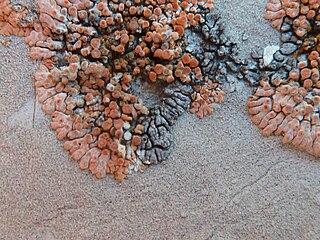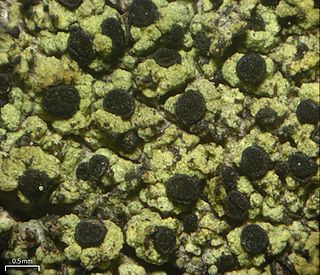
The Verrucariaceae are a family of mostly lichenised fungi in the order Verrucariales. The lichen-forming species have a wide variety of thallus forms, and include crustose (crust-like), foliose (bushy), and squamulose (scaly) representatives. There are several dozen lichenicolous (lichen-dwelling) examples in the family, and some genera that contain solely lichenicolous members. An unusually wide variety of photobiont partners have been recorded, mostly green algae, but also brown algae and yellow-green algae. The family, circumscribed nearly two centuries ago, now includes 56 genera and over one thousand species. Most diversity occurring in the temperate climates of the Northern Hemisphere. Rocks and soil are the most common substrates for the Verrucariaceae, with growth on wood and bark less common. Some semi-aquatic lichens occur in this family, including about two dozen species of marine lichens.

Calicium is a genus of leprose lichen lichens. It is in the family Caliciaceae.

Dermatocarpon is a genus of lichens in the family Verrucariaceae.

Verrucaria is a genus of lichenized (lichen-forming) fungi in the family Verrucariaceae.

The Caliciaceae are a family of mostly lichen-forming fungi belonging to the class Lecanoromycetes in the division Ascomycota. Although the family has had its classification changed several times throughout its taxonomic history, the use of modern molecular phylogenetic methods have helped to establish its current placement in the order Caliciales. Caliciaceae contains 36 genera and about 600 species. The largest genus is Buellia, with around 300 species; there are more than a dozen genera that contain only a single species.
Adolf Hugo Magnusson was a Swedish naturalist who specialized in lichenology. He was a school teacher in Gothenburg from 1909 to 1948, but spent his spare time on the study of lichens. He described about 900 new taxa, specializing in the genera Lecidea, Lecanora, Caloplaca, and Acarospora.

Calicium viride, commonly known as the green stubble lichen, is a species of pin lichen in the family Caliciaceae, and the type species of the genus Calicium. It is a common and widely distributed species in temperate areas of the Northern Hemisphere and southern South America.

Gunnar Bror Fritiof Degelius was a Swedish lichenologist. Between the publications of his first and final scientific papers, Degelius had a 70-year-long research career. While he was best known for his expertise on the lichen genus Collema, he also wrote important papers on lichen biology and ecology, floristic studies of the Nordic countries and various other areas around the world, and lichen succession. Degelius described 124 new taxa, and published about 130 scientific papers. In 1992 he was one of the first to be awarded the Acharius Medal for his lifetime contributions to lichenology. Fifteen species and three genera have been named in honour of Degelius.
Orvo Vitikainen is a Finnish lichenologist. He entered the University of Helsinki in 1961, from where he obtained a Candidate of Philosophy degree in 1966, and a Licentiate of Philosophy in 1971. He later earned a Ph.D. from this institution in 1994, under the supervision of Teuvo Ahti. Between the years 1961 and 1981 he was a junior curator of cryptogams at the University of Helsinki Botanical Garden, and then from 1983 to 2004 he was the head of the lichen herbarium. Here he managed the internationally valuable collections of the early lichenologists Erik Acharius and William Nylander. He has collected thousands of specimens for the herbarium from various locations in Finland, but also internationally, including Sweden, Norway, Denmark, Russian Karelia, Scotland, Austria, Italy, Hungary, Croatia, Montenegro, Tanzania, Kenya, British Columbia, and Brazil. In 1992–1994, he was a scientist of the Finnish Academy in the Ahti research group.

Calicium trabinellum, commonly known as the yellow-collar stubble lichen, is a widespread species of pin lichen in the family Caliciaceae. It was first described by Swedish lichenologist Erik Acharius in 1803 as Calicium xylonellum ß trabinellum. He made the new combination Calicium trabinellum in a later chapter of the same publication.
Calicium episcalare is a rare species of pin lichen that is known from only a single locality in Sweden. It one of the few Calicium species that is parasitic on another lichen. The type was found growing on the north-facing wall of an old wooden barn in Dalsland. The barn, which dates to the 17th century, was made from old pine wood and had likely never been painted. The specific epithet episcalare refers to the name of the host, Hypocenomyce scalaris, a common and widespread lichen. Calicium episcalare was described as a new species in 2016 by Swedish lichenologists Leif Tibell and Tommy Knutsson.

Verrucula is a genus of lichenicolous (lichen-dwelling) lichens in the family Verrucariaceae. Species in the genus are parasitic on saxicolous (rock-dwelling), crustose lichens, including Xanthoria elegans as well as lichens from genus Caloplaca that contain chemical substances called anthraquinones.
Verrucaria rhizicola is a rare species of corticolous (bark-dwelling), aquatic, crustose lichen in the family Verrucariaceae. Found in France, it was formally described as a new species in 2011 by lichenologists André Aptroot and Holger Thüs. The type specimen was collected by the first author from the Forêt de Boulogne (Pas-de-Calais). There, the lichen was growing on the roots of common alder. It is only known from the type collection. The species epithet rhizicola refers to its growth on roots. The roots holding the lichen are located along a stream in a temperate forest, and as such, the lichen is regularly immersed in fresh water. Verrucaria rhizicola is one of about 20 corticolous species in genus Verrucaria. In addition to its uncommon habitat, other unique characteristics of this species are the prominent, minute, shiny ascomata that have a distinctive dimidiate involucrellum, and the asymmetrically kidney-shaped ascospores.
Verrucaria madida is a species of saxicolous (rock-dwelling), aquatic, crustose lichen in the family Verrucariaceae. Found in Europe, it was formally described as a new species in 2004 by British lichenologist Alan Orange. The type specimen was collected by the author west of Murat, Cantal, France at an altitude of about 1,000 m (3,300 ft). There it was growing on shallowly submerged rocks in a lightly shaded woodland stream. The lichen has a thin, smooth, dark green to dark greenish-grey thallus with a somewhat gelatinous consistency. The asci of Verrucaria madida contain four ascospores; this is highly unusual for genus Verrucaria, which typically has eight-spored asci.

The following outline provides an overview of and topical guide to lichens.

Calicium pinicola is a species of lignicolous (wood-dwelling), crustose lichen in the family Caliciaceae. It is widely distributed in Europe, and also occurs in the United States.